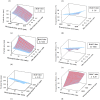Enhanced physicochemical stability and efficacy of angiotensin I-converting enzyme (ACE) - inhibitory biopeptides by chitosan nanoparticles optimized using Box-Behnken design
- PMID: 29991723
- PMCID: PMC6039471
- DOI: 10.1038/s41598-018-28659-5
Enhanced physicochemical stability and efficacy of angiotensin I-converting enzyme (ACE) - inhibitory biopeptides by chitosan nanoparticles optimized using Box-Behnken design
Abstract
Bromelain-generated biopeptides from stone fish protein exhibit strong inhibitory effect against ACE and can potentially serve as designer food (DF) with blood pressure lowering effect. Contextually, the DF refer to the biopeptides specifically produced to act as ACE-inhibitors other than their primary role in nutrition and can be used in the management of hypertension. However, the biopeptides are unstable under gastrointestinal tract (GIT) digestion and need to be stabilized for effective oral administration. In the present study, the stone fish biopeptides (SBs) were stabilized by their encapsulation in sodium tripolyphosphate (TPP) cross-linked chitosan nanoparticles produced by ionotropic gelation method. The nanoparticles formulation was then optimized via Box-Behnken experimental design to achieve smaller particle size (162.70 nm) and high encapsulation efficiency (75.36%) under the optimum condition of SBs:Chitosan mass ratio (0.35), homogenization speed (8000 rpm) and homogenization time (30 min). The SBs-loaded nanoparticles were characterized for morphology by transmission electron microscopy (TEM), physicochemical stability and efficacy. The nanoparticles were then lyophilized and analyzed using Fourier transform infra-red spectroscopy (FTIR) and X-ray diffraction (XRD). The results obtained indicated a sustained in vitro release and enhanced physicochemical stability of the SBs-loaded nanoparticles with smaller particle size and high encapsulation efficiency following long period of storage. Moreover, the efficacy study revealed improved inhibitory effect of the encapsulated SBs against ACE following simulated GIT digestion.
Conflict of interest statement
The authors declare no competing interests.
Figures





Similar articles
-
Optimization, physicochemical stability and in vivo study of alginate-chitosan composites as nanocarriers for low molecular weight angiotensin I-converting enzyme (ACE)-inhibitory peptide.J Food Drug Anal. 2024 Sep 13;32(3):358-370. doi: 10.38212/2224-6614.3522. J Food Drug Anal. 2024. PMID: 39636769 Free PMC article.
-
Improved In Vivo Efficacy of Anti-Hypertensive Biopeptides Encapsulated in Chitosan Nanoparticles Fabricated by Ionotropic Gelation on Spontaneously Hypertensive Rats.Nanomaterials (Basel). 2017 Dec 2;7(12):421. doi: 10.3390/nano7120421. Nanomaterials (Basel). 2017. PMID: 29207480 Free PMC article.
-
Formulation of simvastatin chitosan nanoparticles for controlled delivery in bone regeneration: Optimization using Box-Behnken design, stability and in vivo study.Int J Pharm. 2020 Mar 15;577:119038. doi: 10.1016/j.ijpharm.2020.119038. Epub 2020 Jan 15. Int J Pharm. 2020. PMID: 31953085
-
Novel amphiphilic chitosan nanocarriers for sustained oral delivery of hydrophobic drugs.Eur J Pharm Sci. 2017 Mar 1;99:285-291. doi: 10.1016/j.ejps.2016.12.035. Epub 2017 Jan 3. Eur J Pharm Sci. 2017. PMID: 28057549
-
Chitosan Nanoparticles Prepared by Ionotropic Gelation: An Overview of Recent Advances.Crit Rev Ther Drug Carrier Syst. 2016;33(2):107-58. doi: 10.1615/CritRevTherDrugCarrierSyst.2016014850. Crit Rev Ther Drug Carrier Syst. 2016. PMID: 27651100 Review.
Cited by
-
Dual-Loaded Nanocarriers With High Stability in Gastrointestinal Tract for Type 2 Diabetes and Hypertension Prevention.Food Sci Nutr. 2025 Jun 8;13(6):e70394. doi: 10.1002/fsn3.70394. eCollection 2025 Jun. Food Sci Nutr. 2025. PMID: 40491979 Free PMC article.
-
Protective Action of Jania rubens Nanoencapsulated Algal Extract in Controlling Vegetable Oils' Rancidity.ACS Omega. 2021 Feb 15;6(8):5642-5652. doi: 10.1021/acsomega.0c06069. eCollection 2021 Mar 2. ACS Omega. 2021. PMID: 33681603 Free PMC article.
-
Current Evidence on the Bioavailability of Food Bioactive Peptides.Molecules. 2020 Sep 29;25(19):4479. doi: 10.3390/molecules25194479. Molecules. 2020. PMID: 33003506 Free PMC article. Review.
-
GABA enhancement by simple carbohydrates in yoghurt fermented using novel, self-cloned Lactobacillus plantarum Taj-Apis362 and metabolomics profiling.Sci Rep. 2021 May 3;11(1):9417. doi: 10.1038/s41598-021-88436-9. Sci Rep. 2021. PMID: 33941803 Free PMC article.
-
Angiotensin Converting Enzyme (ACE)-Peptide Interactions: Inhibition Kinetics, In Silico Molecular Docking and Stability Study of Three Novel Peptides Generated from Palm Kernel Cake Proteins.Biomolecules. 2019 Oct 4;9(10):569. doi: 10.3390/biom9100569. Biomolecules. 2019. PMID: 31590308 Free PMC article.
References
-
- Lee, J. K., Jeon, J. K., Kim, S. K. & Byun, H. G. Characterization of Bioactive Peptides Obtained from Marine Invertebrates. Adv. Food Nutr. Res. 65 (Elsevier Inc., 2012). - PubMed
-
- Kim, S-K. & Himaya, S. W. A. Edible Marine Invertebrates; A promising Source of Nutracueticals. (ed. Kim S.-K.) 243–256 (Boca Raton: CRC Press Taylor & Francis, 2013).
-
- Harnedy PA, FitzGerald RJ. Bioactive peptides from marine processing waste and shellfish: A review. J. Funct. Foods. 2012;4:6–24. doi: 10.1016/j.jff.2011.09.001. - DOI
Publication types
MeSH terms
Substances
Grants and funding
- No. 02-01-04-SF 2309/Ministry of Science, Technology and Innovation, Malaysia | Akademi Sains Malaysia (Academy of Sciences Malaysia)/International
- No. 02-01-04-SF 2309/Ministry of Science, Technology and Innovation, Malaysia | Akademi Sains Malaysia (Academy of Sciences Malaysia)/International
- No. 02-01-04-SF 2309/Ministry of Science, Technology and Innovation, Malaysia | Akademi Sains Malaysia (Academy of Sciences Malaysia)/International
- No. 02-01-04-SF 2309/Ministry of Science, Technology and Innovation, Malaysia | Akademi Sains Malaysia (Academy of Sciences Malaysia)/International
- No. 02-01-04-SF 2309/Ministry of Science, Technology and Innovation, Malaysia | Akademi Sains Malaysia (Academy of Sciences Malaysia)/International
LinkOut - more resources
Full Text Sources
Other Literature Sources
Miscellaneous

